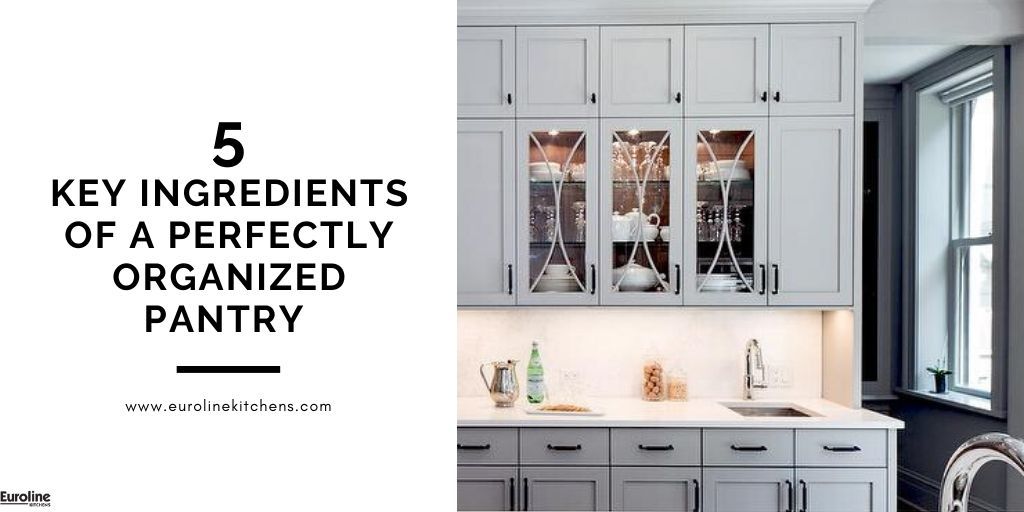Few things are as satisfying as a neat and organized cooking space where every item has a place. Having everything organized makes prepping, cooking and cleaning easier and more fun. No matter the size of your kitchen, you need a dedicated pantry to store all your essential food items and cooking appliances. The idea is to utilize the available space in your kitchen to create a pantry for a better cooking experience. When you’re busy selecting cabinet colours and preparing grocery lists, it’s easy to miss out on the small details that make all the difference in the look and functionality of the space.

5 Key Elements to Consider When Planning a Pantry
Pantries are useful and attractive additions to any kitchen. Besides keeping things organized, they create a visual centre of interest. Here are five essential elements to keep in mind when designing an efficient pantry.
- Use Proper Lights
Most people don’t pay enough attention to the lighting in their pantry. Since most are built without a window or (maybe) just a small one, it’s important to make sure that there’s adequate light. Install bright, overhead LED lights for ambient lighting and under-shelf lights for better visibility. If you live in a single-floor home, you may also opt for a skylight. Make sure that the light switches are within easy reach and mounted somewhere near the pantry door.
- Choose the Right Pantry Door
A common mistake homeowners make when designing a kitchen pantry is choosing the wrong door. Basically, there are two types of pantry doors – sliding and folding. For kitchens where space is at a premium, sliding and outward-folding doors are best. While sliding doors are popular for their space saving and lightweight design, outward-opening hinged doors give more space for pantry shelves. Traditional doors that open inward are not always a good option (especially for small kitchens), because they require a lot of space behind them. Always consider the space and traffic flow in your kitchen when choosing a pantry door.
- Keep a Ladder Handy
As discussed above, getting the right kind of storage space is important. For example, big containers with more height will require spacious shelves and cabinets that can accommodate them. But, what’s the point of installing a floor-to-ceiling cabinet if you can’t access items on the top shelf? So, it’s a good idea to have a step ladder or foot stool to fetch things that are out of reach. One easy way to see what’s on your top shelf without climbing a ladder is to use wire racks or glass shelves.
- Consider Budget Materials
A pantry doesn’t always have to be fancy or expensive, but the cabinets and shelves must be made of a hardy material that can withstand daily use and complement the rest of the kitchen. Polished hardwood shelves and powder-coated metal racks are great options. Plywood and engineered wood are inexpensive alternatives; they’re also strong and look amazing, especially when left in their natural state or given a light stain. If you prefer plywood, choose laminated shelves in the colour of your choice. This looks exceptionally smart and clean against the neutral tones of a kitchen.
- Heed Proper Organization
Even the most attractive kitchen cabinets and shelves won’t make your pantry efficient until you organize it. This could be a challenge, especially in small kitchens. Here are a few things that you should consider to keep your pantry organized.
- Keep your frequently required items on the lowest and easiest-to-access shelves.
- Avoid big, broad shelves to prevent items from being lost (and forgotten) in dark corners.
- Use drawer organizers for easy and quick access to kitchen utensils and crockery.
- Use revolving spice racks, jar sets and multipurpose hanging shelf racks to keep things neat and systematized.
- Use any free wall space for hanging hooks, household calendars or perhaps a chalkboard (to note important family events).
The whole purpose behind having a pantry is to store groceries and other kitchen essentials in an organized way. From thoughtful arrangements to personal touches, it’s the little details that add to the ease and functionality of your kitchen. Poorly arranged racks, inadequate lighting and the wrong pantry doors are all avoidable mistakes. Use this quick guide to address these obvious flaws before they happen.


